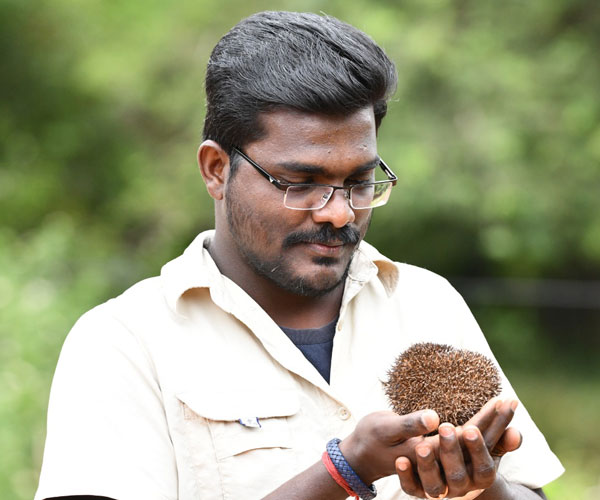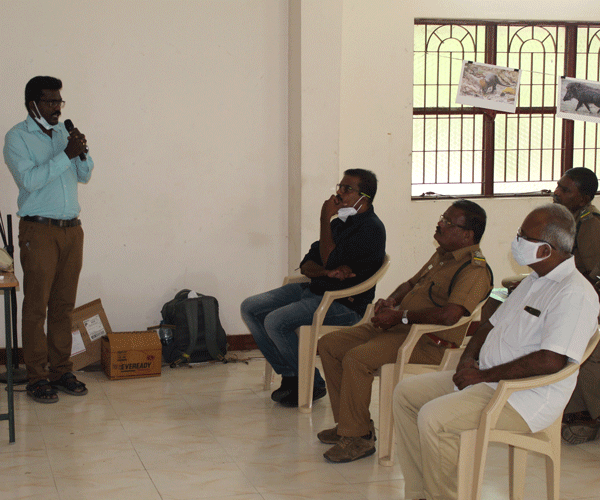
With more than 40,000 species threatened with extinction, very few people would dedicate their lives to protecting small, apparently useless mammals like hedgehogs and rats. Resource restrictions and conservation trends orient the official protection interventions towards black rhinos (Diceros bicornis) (about 5,630 left in 2018) or mountain gorillas (Gorilla gorilla beringei) (over 1,000 alive in 2018), instead. In some places like India, however, rats, bats and other small mammals make up more than 50 per cent of the biodiversity, and they deserve as much protection.
Hedgehogs and rats—small rodents that are ubiquitous in the world—are, in fact, far more important than most people would think, as they both play a critical role in the ecosystems. They are prey for several predators, and they disperse seeds, dig the soil and ease air circulation, to the benefit of plants and other animals.
This is why Indian conservationist Brawin Kumar, a postdoctoral fellow with the Indian Institute of Science Education and Research Tirupati (IISER), chose a life mission: promoting the survival of small mammals like hedgehogs and rats. Kumar is working under the guidance of Assistant Professor Nandini Rajamani, with funds provided by the Government of India through the Department of Science and Technology.
His scientific career began in 2010, when Kumar started working at the Zoo Outreach Organization, studying the Elvira rat (Cremnomys elvira), a critically endangered species living in India. He soon realized that other small mammals were worth studying and deserved protection. One of these was the bare-bellied hedgehog (Paraechinus nudiventris) or Madras hedgehog that lives in the rural landscapes of Tamil Nadu, a south Indian State. "Very little was known about its habits and conservation status, so, I decided to popularize and protect its habitat through scientific research," recalled Kumar.
While pursuing his PhD at the Institute of Zoology of the University of Chinese Academy of Sciences (CAS), in Beijing, where he spent four years (2015–2019) thanks to a TWAS-CAS fellowship, he mainly focused on a rabbit species called Lepus yarkandensis. In parallel, he started conducting surveys on the Madras hedgehog. Receiving the TWAS-CAS Fellowship was a pivotal event, he recalled, because it provided critical support to his work, setting the groundwork for his commitment and future, successful activities.
With their pointed muzzles and teetering gait, hedgehogs elicit tenderness. Scientists have classified 17 species living in Europe, Asia, Africa and Oceania. The Madras hedgehog lives only in India, whereas additional two species— the Hemiechinus collaris and the Paraechinus micropus—live in India and Pakistan.
The Madras hedgehog prefers the dry arid regions and scrubby jungles of southern India, where they typically sleep in the summertime (estivation) because there are fewer insects to feed upon.
Despite a crown of sharp spines that covers their body on the head, back and sides—which protects the animals when they roll themselves into a tight ball to avoid predators—hedgehogs are quite vulnerable. In particular to humans. They are hunted for subsistence food, are used for medicinal purposes in Indian traditional medicine, which uses the flesh and spines to treat tuberculosis and asthma and to offer relief against coughs and leg pain; and they often die in road accidents. Another major cause of their decline is habitat destruction.
"When I started my research, data about their ecology, population trends and number of individuals in Tamil Nadu were scarce," Kumar recalls. "But one thing I was certain about: sound education programmes and innovative conservation actions would help save them."
To acquire information about their lifestyle, in the early phases of his investigation (2013–2014), Kumar carried out field surveys aimed at mapping their resting places and distribution patterns, thus laying the foundations of a decade-long work. Since he could not spot many individuals during several campaigns, so he decided to gather information from the local population, an initiative that he now calls a "successful action of citizen science".
"I interviewed many people, who confirmed having spotted hedgehogs quite often, in the past. The same people admitted that, in recent times, these animals were barely visible," Kumar noted. "This confirms that proper species and habitat conservation can be achieved only by involving the local people."
This consideration prompted Kumar to continue his field-based work to collect scientific data on hedgehogs, with the aim of establishing a permanent hedgehog conservation research centre and a website dedicated to its protection. In the last two years, he has organized 64 wildlife conservation scientific programmes and meetings.
In parallel, he started outreach activities, inspired by United Nations Sustainable Development Goal 4 on quality education. In 2020 and 2021, Kumar organized 18 hedgehog conservation awareness programmes and nine school events, both online and in villages of Tamil Nadu, many of them in collaboration with the Tamil Nadu Science Forum. Each event hosted an average of 55 participants between students and teachers and gave Kumar the chance to present his 20-page comics book titled Mullikkaattu Ithigaasam (Legend of the Scrub Forest), written in Tamil with his artist friend Venkatesh Babu.
Kumar is also liaising with the Indian Government, advocating to upgrade the protection of the Madras hedgehog. At present, two out of three hedgehogs living in India (Hemiechinus collaris and Paraechinus nudiventris) are not included in any schedule of the 1972 Indian Wildlife Protection Act. Only the Indian hedgehog (Paraechinus micropus), which is common in the States of Gujarat and Rajasthan, has been included in schedule IV of the Act, which offers only partial protection.
Kumar's efforts include also the preparation of the Tamil Nadu Hedgehog Conservation Initiative Vision 2030, a road map for the hedgehog conservation drafted for the Forest Department of Tamil Nadu. And he dreams of establishing the National Hedgehog Day, on 30 June each year, in coincidence with the birthday of pioneering Indian wildlife photographer, writer and naturalist Madhaviah Krishnan, who passed away in 1996.
By the end of 2022, he also plans to activate the Hedgehog Mapping Project, based on an application that will be available in three languages (Gujarati, Tamil and Hindi, for the Rajasthan State), to fill the gap still existing with the English language, which is still predominant in Indian textbooks.
His membership with several international associations is helping him to be a champion for the hedgehog and the protection of other mammals. He is affiliated with the International Society of Zoological Sciences; the International Union for Conservation of Nature, where he serves in the Small Mammal Specialist Group; the World Lagomorph Society and the Linnean Society of London.
Despite receiving many grants and awards to study hedgehogs, Kumar has never forgotten other small mammals: "I want to see the lesser-known, Indian fauna in a well-protected status," he said with joy.
Not surprisingly, in 2019, he received a Fondation Segré EDGE Fellowship from the Zoological Society of London, which helped him to launch a two-year (2021–2022) conservation project on the Elvira rat, in the Salem District of Tamil Nadu.
In 2021, he was awarded the Holohil Transmitter Grant from Holohil Systems Limited, Canada, which he used to purchase transmitters for his ongoing fieldwork on the Elvira rat.
So, what about this small rodent? Why is it so important? Well, this is another story worth telling.
Cristina Serra

